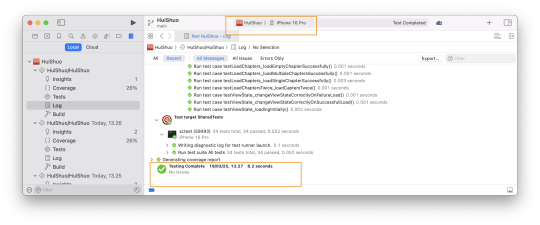#Software Development Practice
Explore tagged Tumblr posts
Text
Software development best practices are the cornerstone of success in today's fast-paced tech landscape. From agile methodologies for flexibility to continuous integration for streamlined releases, each practice ensures smoother processes and higher-quality outcomes. By prioritizing collaboration, reliability, security, and performance, teams deliver software that exceeds expectations, driving success in an ever-evolving digital world.
#Software development practice#Software development best practices#software best practice#software consulting#entrepreneur#software development
0 notes
Text
CI/CD practices have revolutionized the software development process by automating key aspects of building, testing, and deploying software, resulting in faster development cycles
#Devops#Devops Process#Automation Tool#Devops Practice#Software Development Practice#Software Development Lifecycle#Software Development Best Practice#Continuous Deployment#Continuous Integration#CI CD#CI CD Pipeline#CI CD Tools#Continuous Delivery
0 notes
Text
I keep seeing software developers with my same degree, who get payed (presumably) the same as me, bragging that they copy-paste code from chatgpt, and like... Do you not have dignity? Aren't you ashamed of yourselves? The average quality of code is already abysmal, what is there to be proud in making it worse?
#software development#computer science#CS is a branch of mathematics#we could be writing code that is provably correct#instead the best practices want us to write code that is 'maybe' correct#and now we've started copy-pasting code that is provably wrong#i think we should start from scratch#back from the top#back to the turing machine and the lambda calculus#maybe we can get something better this time around
99 notes
·
View notes
Text
Maintaining fast unit test feedback is crucial as an app and team grow over time. Without proper modularization, unit testing can become painfully slow. By structuring code into independent modules and utilizing macOS-based testing strategies, we can drastically improve test execution speed. This results in faster development, quicker bug fixes, and a smoother engineering experience. If you’re working on a growing iOS project, now is the time to start modularizing. Not only will it save you time today, but it will keep your project maintainable and efficient as your team and codebase scale. Start with one module, test the benefits, and see the difference! 🚀

View On WordPress
#Good Programming Practice#Ios Development#Modularization#Software Development#Software Engineering#Test Driven Development
0 notes
Text
Scrum, Actually: Fixing the Daily Catch-Up
We called it a “daily catch-up.”It felt more like a group panic disguised as a status update.Nobody knew why we were doing it—just that we had to. Then I read the Scrum Guide.Turns out, we were doing it wrong. Here’s how we fixed it. The first time I experienced a Daily Scrum, I thought it was a job interview. Every day. For the same job. That I already had. At 9:30 AM, we’d gather like…
#agile#agile coaching#Agile Practices#agile transformation#collaboration#Daily Scrum#engineering culture#Planning#Please Don’t Fire Me Theatre#Schrödinger’s Blocker#scrum#scrum master#software development#Stand-up Meetings#Team Culture#Tech Teams#trust
0 notes
Text
Navigating the Nervous Waters of Coding
Daily writing promptWhat makes you nervous?View all responses AI-generated image. “This code is going well…a little too well.” The Code Creep: Why Every Line Can Feel Like a Tightrope Walk What makes me nervous? You might think it’s a looming deadline or a particularly gnarly algorithm. And while those definitely get the heart racing, the real source of my coding jitters? It’s the act of…
#Artificial Intelligence#best practices#c#c++#career advice#Cloud computing#coding#dailyprompt#dailyprompt-1916#data science#debugging#devops#java#javascript#machine learning#mobile development#Programming#python#software development#testing#tutorials#web development
1 note
·
View note
Text
Explore the top API development best practices in 2025 with Xicom Technologies. This comprehensive guide covers everything from API design and versioning to robust security, clean coding, and documentation to help developers build secure, scalable, and high-performing APIs.
0 notes
Text

Serrv.ai brings the Best Audit Software in India, enabling CAs to automate audit workflows, track compliance, and generate reports seamlessly.
https://www.serrv.ai/practeaseca/
#audit automation#management software#audit software#practice management software#software#software development
0 notes
Text
#Software Development Trends#Top Tech Trends#IT Innovation#Agile Development#DevOps Practices#Digital Transformation#Emerging Technologies#Cloud Computing#Custom Software Trends#Future of Software Development
1 note
·
View note
Text
Latest in Tech and Programming.

Who We Are
Welcome to Geekonik, your go-to platform for mastering the latest in tech and programming. Whether you’re a beginner eager to start your coding journey or an experienced developer looking to sharpen your skills, we offer a diverse range of expert-led courses designed to help you succeed in today’s ever-evolving tech industry.
Let the Numbers Speak
✅ 200+ Courses
✅ 30+ Expert Instructors
✅ 4000+ Students and Growing
Our Vision
At Geekonik, we believe learning tech should be both practical and enjoyable. That’s why our curriculum is constantly updated to reflect the latest trends, technologies, and best practices. Join us today and take the first step toward becoming a skilled programmer or tech professional!
Our Mission
Our mission is simple: to make technology and programming education accessible, engaging, and impactful for learners of all backgrounds. We are committed to equipping individuals with the skills and knowledge they need to thrive in the digital world.
Through hands-on projects, expert-led courses, and a collaborative learning environment, we inspire curiosity, foster growth, and empower the next generation of tech professionals. Our goal is to bridge the gap between learning and real-world application, ensuring our students are ready to tackle the challenges and opportunities of the future.
Success Stories
🚀 "Geekonik transformed my career! I went from zero coding experience to landing my first developer job in just six months. The hands-on projects made all the difference!" – Alex R., Software Engineer
Join the Geekonik community today and start building the future of tech—one skill at a time!
Call Us
+91 9560562455
Our Location
H140 Fourth Floor Sector 63 Noida
Website
##Who We Are#Welcome to Geekonik#your go-to platform for mastering the latest in tech and programming. Whether you’re a beginner eager to start your coding journey or an ex#we offer a diverse range of expert-led courses designed to help you succeed in today’s ever-evolving tech industry.#Let the Numbers Speak#✅ 200+ Courses#✅ 30+ Expert Instructors#✅ 4000+ Students and Growing#Our Vision#At Geekonik#we believe learning tech should be both practical and enjoyable. That’s why our curriculum is constantly updated to reflect the latest tren#technologies#and best practices. Join us today and take the first step toward becoming a skilled programmer or tech professional!#Our Mission#Our mission is simple: to make technology and programming education accessible#engaging#and impactful for learners of all backgrounds. We are committed to equipping individuals with the skills and knowledge they need to thrive#Through hands-on projects#expert-led courses#and a collaborative learning environment#we inspire curiosity#foster growth#and empower the next generation of tech professionals. Our goal is to bridge the gap between learning and real-world application#ensuring our students are ready to tackle the challenges and opportunities of the future.#Success Stories#🚀 “Geekonik transformed my career! I went from zero coding experience to landing my first developer job in just six months. The hands-on pr#Software Engineer#Join the Geekonik community today and start building the future of tech—one skill at a time!#Call Us
1 note
·
View note
Text
Why Rushing into Coding Can Doom Your Software Project
Jumping straight into writing code without proper planning can lead to costly mistakes, rework, and project failure. Learn why a strategic approach, including requirements gathering and design, is essential for successful software development.
#Software Development#Coding Best Practices#Project Management#Software Engineering#Agile Development#Code Quality
0 notes
Text
The Dependency Inversion Principle (DIP) is a fundamental concept in software development that helps create flexible and maintainable code. In this article, I'll explore its history, the problem of tight coupling, and different approaches to applying DIP in Swift.
#Dependency Inversion Principle#DIP#Good Programming Practice#Ios Development#Software Development#Software Engineering#SOLID
0 notes
Text
Information Warfare and Game Theory: A Cybersecurity Perspective
Throughout my career as a software architecture specialist, I've observed a fascinating paradox: while we meticulously craft complex systems and architectures, cybersecurity often remains an afterthought for many developers. They tend to view it as someone else's responsibility – typically the organization's dedicated security team.
Recently, while researching "Game Theory in Information Warfare" for an academic report, I discovered an exceptional article by Brett Turner, a Cybersecurity Architect at World Wide Technology (WWT). Turner's piece masterfully explores the application of game theory principles in cybersecurity risk management, offering fresh perspectives on how we approach digital defense strategies.
What particularly resonates with me is how this intersection of game theory and cybersecurity challenges the traditional divide between development and security teams. As someone primarily focused on software architecture, I've come to recognize that building robust security measures into our system designs from the ground up isn't just best practice – it's becoming increasingly crucial for reducing institutional cybersecurity costs.
Turner's article (4.5/5 in my assessment) brilliantly articulates these concepts with exceptional clarity and logical progression. For those looking to deepen their understanding of cybersecurity strategy, I highly recommend reading his insights at WWT's blog:
From Games to Gains: The Role of Game Theory and Gamification in Cybersecurity Risk Management.
What are your thoughts on integrating game theory principles into cybersecurity strategy? I'd love to hear your perspectives on bridging the gap between development and security.
#cybersecurity best practices#software development#web development#dotnet#csharp#education#developer
0 notes
Text
Rethinking Estimations in the Age of AI
Rethinking estimations in AI-driven processes has become essential in the fast-paced world of IT and software development. Estimations shape project timelines, budgets, and expectations, yet traditional practices often lead to inefficiency and frustration. In a previous post, I explored the #NoEstimates movement and its call to move beyond traditional estimation techniques. Here, I’ll dive deeper…
#agile practices#AI#data-driven#Efficiency#estimations#historical data#IT industry#predictability#project planning#software development
0 notes
Text
Returning To The Basics: A New Series
I was originally going to write a post about reactivity in Svelte, but when going over the tutorial section, I realized I had so many questions that the post would take me weeks to write well.
I realized that my understanding of the basics could be better. So, I've decided to start a new series digging into the nitty gritty details of web development.
I won't have a particular order to the series, but I'll write posts based on my questions as I continue studying Svelte, reading MDN documentation, and through practical experience.
My first post will be about the Document Object Model (DOM), which was my first question when going through reactivity in Svelte.
Hopefully, I'll have it done this weekend or sometime during the week!
#coding#developer#framework#growth#learning#programming#svelte#tech#web development#website development#codeblr#code#htmlcoding#html css#html#html5#css#javascript#back to basics#practice#experience#studying#software development#software#development#technologies
0 notes
Text
Mike has about 50 questions he expects all professional software engineers he works with to be able to answer. Many of them are widely applicable, and useful to think about. This mind-map provides a visual summary of them, useful as a quick reminder and review tool.
0 notes